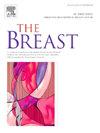Long-term outcomes of three distinct once-daily schedules for accelerated partial breast irradiation
IF 5.7
2区 医学
Q1 OBSTETRICS & GYNECOLOGY
引用次数: 0
Abstract
Background and purpose
To date, accelerated partial breast irradiation (APBI) regimens are highly heterogeneous. Twice-daily schedules show comparable local control to whole-breast radiotherapy but with worse toxicity and cosmesis profiles. Conversely, once-daily regimens are better tolerated, though dose and number of fractions are yet not standardized. Therefore, the aim of this study was to evaluate the efficacy and tolerability of three different once-daily APBI schedules.
Materials and methods
Three consecutive phase-2 trials were conducted at a single national cancer center to assess three once-daily APBI schedules (40Gy in 10 fractions, 35Gy in 7 fractions, and 28Gy in 4 fractions) delivered with 3D-conformal radiotherapy. All patients were at least 60 years old and had early-stage breast cancer (pT1-2,pN0-N1mic). Toxicity and cosmesis were evaluated by physicians using the CTCAE 4.0 scale and the Harvard score, respectively. Recurrence rates and survival outcomes at 5 and 10 years were estimated using the Kaplan-Meier method.
Results
A total of 189 patients were enrolled, with a median follow-up of 10.2 years. Patients treated with 40Gy in 10 fractions, 35Gy in 7 fractions and 28Gy in 4 fractions were 80 (42%), 73 (39%), and 36 (19%), respectively. Acute toxicity was low and comparable across schedules, whereas grade≥2 late toxicity and poor cosmesis were significantly worse with the shorter schedule. The 10-year estimated in-breast tumour recurrence rate was 5.5%, comparable to the limited literature reporting long-term outcomes.
Conclusions
Once-daily APBI delivered with 3D-conformal radiotherapy was effective; however, regimens with fewer than 5 fractions may be associated with increased toxicity and worse cosmesis.
三种不同的每日一次加速部分乳房照射方案的长期结果
背景和目的迄今为止,加速乳腺部分照射(APBI)方案的差异很大。每天两次的方案显示出与全乳腺放疗相当的局部控制效果,但毒性和疤痕情况较差。相反,每日一次的方案耐受性更好,但剂量和分次数量尚未标准化。因此,本研究旨在评估三种不同的每日一次 APBI 方案的疗效和耐受性。材料和方法在一个国家癌症中心连续进行了三项 2 期试验,评估了三种每日一次 APBI 方案(40Gy 分 10 次、35Gy 分 7 次和 28Gy 分 4 次),并采用三维适形放疗。所有患者的年龄均在60岁以上,且均为早期乳腺癌(pT1-2,pN0-N1mic)。医生分别使用 CTCAE 4.0 评分标准和哈佛评分标准对患者的毒性和外观进行评估。采用 Kaplan-Meier 法估算复发率和 5 年及 10 年生存率。接受40Gy分10次、35Gy分7次和28Gy分4次治疗的患者分别为80人(42%)、73人(39%)和36人(19%)。各疗程的急性毒性较低且不相上下,而≥2级的晚期毒性和外观不佳则明显低于较短疗程。结论每天一次的APBI配合三维适形放疗是有效的;但是,少于5个分割的治疗方案可能会导致毒性增加和外观不佳。
本文章由计算机程序翻译,如有差异,请以英文原文为准。
求助全文
约1分钟内获得全文
求助全文
来源期刊

Breast
医学-妇产科学
CiteScore
8.70
自引率
2.60%
发文量
165
审稿时长
59 days
期刊介绍:
The Breast is an international, multidisciplinary journal for researchers and clinicians, which focuses on translational and clinical research for the advancement of breast cancer prevention, diagnosis and treatment of all stages.
 求助内容:
求助内容: 应助结果提醒方式:
应助结果提醒方式:


